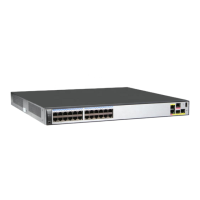8.8.2 Example for Configuring the Redirection Function for Remote
Device Management
This section provides an example to illustrate how to configure the redirection function. This
function allows you to manage remote devices through asynchronous serial interfaces.
Networking Requirements
As shown in Figure 8-9, RouterB fails and users can only log in to it through the console port.
Only users in VPN instance vpna are allowed to log in to RouterB. There is a reachable route
between vpna and RouterA.
Connect the console port of RouterB to an asynchronous serial interface of RouterA, enable the
redirection function on RouterA, and associate the redirection function with vpna. The users in
vpna can use a specified port number to log in to RouterB.
Figure 8-9 Networking diagram for redirection configuration
Network
Console
PC
RouterA RouterB
Async2/0/1
Session
GE0/0/1
10.1.1.1/24
vpna
Configuration Roadmap
The configuration roadmap is as follows:
1. Connect the console port of RouterB to an asynchronous serial interface of RouterA.
2. Enable the redirection function on RouterA.
Data Preparation
To complete the configuration, you need the following data:
l IP address of the network-side interface on RouterA: 10.1.1.1/24
Procedure
Step 1 Configure the asynchronous serial interface to work in flow mode.
<Huawei> system-view
[Huawei] sysname RouterA
[RouterA] interface async 5/0/1
[RouterA-Async5/0/1] async mode flow
Step 2 Obtain the TTY user interface number corresponding to the asynchronous serial interface.
[RouterA] display user-interface
Idx Type Tx/Rx Modem Privi ActualPrivi Auth Int
0 CON 0 9600 - 15 - N -
41 TTY 41 9600 input 0 - N 5/0/0
F 42 TTY 42 9600 - 0 - N 5/0/1
Huawei AR2200 Series Enterprise Routers
Configuration Guide - Basic Configuration 8 Accessing Another Device
Issue 02 (2011-10-15) Huawei Proprietary and Confidential
Copyright © Huawei Technologies Co., Ltd.
155

